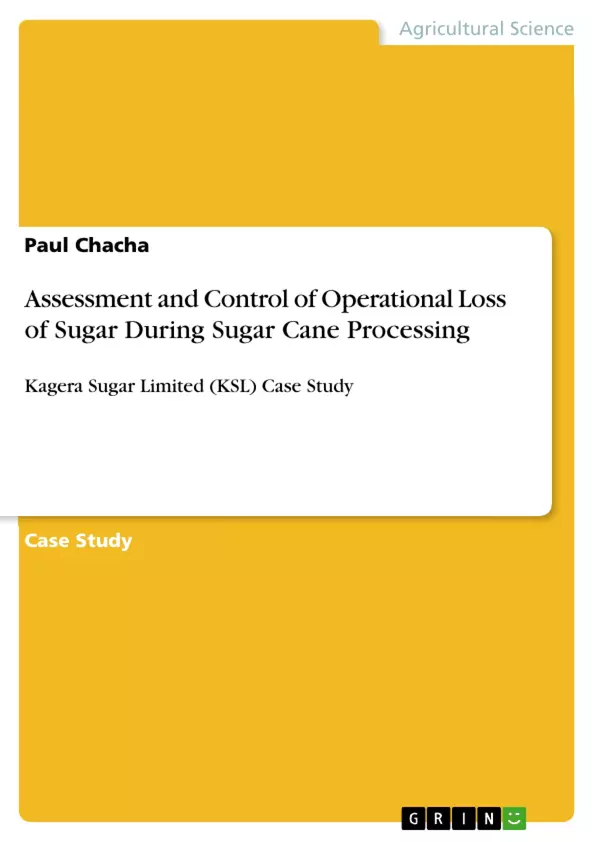This paper concentrated on assessing and controlling the operational loss of sugar in various sugar byproducts during cane processing in cane sugar factory.
In the study, factors associated with operational loss were discussed and Kagera Sugar Limited (KSL) was taken as a case study. Operational sucrose loss is divided into two major categories namely, determined losses and undetermined losses. Determined losses are those which can be easily quantified through lab analysis, such as loss in molasses, filter cake and bagasse. Unlike determined losses, undetermined losses are difficult to estimate directly but rather by factory material balance.
Undetermined loss is further classified into chemical loss, mechanical loss and administrative loss. In both losses, the loss through molasses is by far the largest of total loss encountered during cane processing. Objective of this paper was to develop means of increasing sucrose recovery by monitoring sugar loss. After analyzing data collected from KSL production reports, for crushing seasons 2015/16 and 2016/17 the operational loss was 2.83 and 2.87 pol % cane crushed in respective seasons.
This means KSL loses significant amount of sucrose as compared to 2.20 pol% cane crushed for plants installed after 1994 as reported by. Sugar loss in molasses and bagasse was high than others, it was concluded that, the use of three laws of sucrose loss in molasses coupled with optimization of boiling house operations would result in minimized loss of sucrose in molasses. Also, improving extraction would result in minimum sucrose loss in bagasse.
Table of Contents
- Abstract
- 1. Introduction
- 1.1 Sugar production process
- 1.2 Background of the problem
- 1.3 Significance of the study
- 1.4 Methodology
- 2. Results and Discussion
- 2.1 Sugar loss in final molasses
- 2.1.1 How is sugar lost in molasses?
- 2.1.2 What to be done to minimize sugar loss in molasses?
- 2.2 Sugar loss in bagasse
- 2.2.1 What to be done to minimize sugar loss in final bagasse?
- 2.3 Sugar loss in filter cake
- 2.3.1 What to do to further minimize sucrose loss in filter cake?
- 2.4 Sugar loss in undetermined channels:
- 2.1 Sugar loss in final molasses
- 3. General conclusion
- References
Objectives and Key Themes
This paper investigates the operational loss of sugar during sugarcane processing at Kagera Sugar Limited (KSL) in Tanzania. The study aims to analyze the factors contributing to these losses and develop strategies for improving sucrose recovery.
- Assessing operational sugar loss in various sugar byproducts.
- Analyzing the impact of determined and undetermined losses on sugar production.
- Identifying key factors influencing sugar loss in molasses, bagasse, and filter cake.
- Developing strategies to minimize sugar loss and enhance sucrose recovery.
- Comparing KSL's operational losses to industry standards and best practices.
Chapter Summaries
The introduction provides a general overview of the sugar production process, highlighting the importance of maximizing sucrose recovery and minimizing losses. The paper then focuses on KSL, detailing the background of the problem and the need for improving sugar loss management. The results and discussion section delve into the various types of sugar losses, specifically in molasses, bagasse, and filter cake. Strategies for minimizing each type of loss are discussed in detail. The paper concludes with a general summary and recommendations for future research.
Keywords
Sugar production, operational sugar loss, molasses exhaustion, bagasse, sugar boiling house, sugar mill, sucrose recovery, sugar byproducts, determined losses, undetermined losses, material balance, chemical loss, mechanical loss, administrative loss, efficiency, optimization.
- Citar trabajo
- Paul Chacha (Autor), 2020, Assessment and Control of Operational Loss of Sugar During Sugar Cane Processing, Múnich, GRIN Verlag, https://www.grin.com/document/539319



